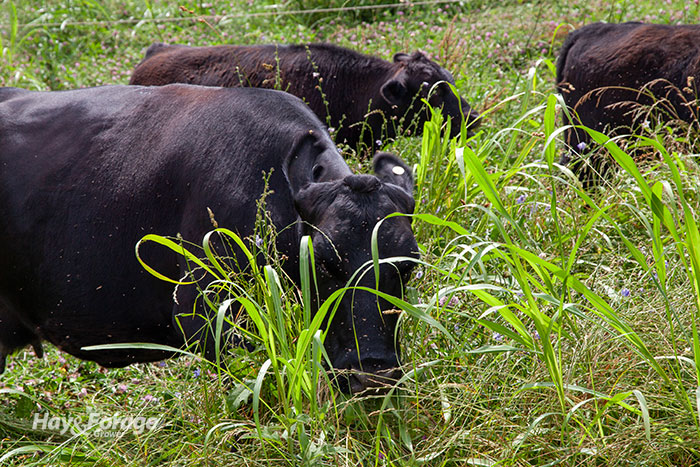A tale of two forage disorders |
| By Amber Friedrichsen, Associate Editor |
|
|
 More than 70 cattle were recently reported dead after grazing johnsongrass in southwest Missouri. While prussic acid was deemed the most likely cause of death, diagnosticians did consider nitrate toxicity as an explanation for the sudden outbreak. The two seasonal disorders are often coupled together as ailments associated with sorghum species; however, they have considerable differences. Tim Evans with the University of Missouri notes the cattle were released to a pasture of drought-stressed johnsongrass that had a flush of fresh forage following a recent rain. The risk of prussic acid poisoning is heightened when enough precipitation interrupts a dry period to encourage new plant growth. Evans, a veterinary toxicologist, says after a few hours of grazing the young johnsongrass, animals began staggering and collapsing before ultimately dying. Incidents like this seem to be made public every year to remind farmers to be privy to prussic acid poisoning. Forages like sorghum, sudangrass, sorghum-sudangrass, and johnsongrass produce a compound called dhurrin in the plant leaf cells. Dhurrin is converted to prussic acid, or cyanide, when young forage tissue is broken down by rumen microbes, or when forage is stressed by extreme weather, like a frost. Evans explains prussic acid then inhibits aerobic metabolism and prevents oxygen from being transported in the bloodstream. The disorder can be deadly for cattle, sheep, and goats. Although further testing supports the hypothesized cause of death of cattle in The Show-Me State, prussic acid poisoning and nitrate toxicity are triggered by similar growing conditions, especially in the Upper Midwest. Even so, the two diagnoses have different implications on animal health and require separate management tactics. In an article from the Midwest Forage Association’s Forage Focus newsletter, Yoana Newman with the University of Wisconsin Extension compares prussic acid poisoning and nitrate toxicity. The forage specialist explains how these disorders can develop and the best ways to mitigate their negative effects. Prussic acid poisoning Newman points out that prussic acid poisoning is most likely to occur when livestock graze new tillers that are less than 20 inches tall. Dhurrin is quick to accumulate in immature forage tissues like that of the fast-growing johnsongrass plants that popped up in the drought-stricken pastures of southwest Missouri. The second scenario that elicits prussic acid poisoning is a killing frost. This blast of cold weather causes plant cells to burst, which initiates the conversion of dhurrin into prussic acid. In this case, avoid grazing cattle in stands of sorghum species for five to seven days to allow the prussic acid gas to volatize. Even then, Newman cautions producers of possible unprecedented outcomes. “Be careful with frozen stands,” the forage specialist asserts. “Cattle may avoid the frozen portion and go for young tillers at the base of the plant, which can be extremely toxic.” In contrast to grazing, prussic acid poisoning is less of a concern when forage is harvested for hay or silage. Toxicity levels are typically low in plant tissues by the time forage is mature enough to make hay, and any prussic acid present after cutting will dissipate during dry down. The toxic compound can also dissipate during fermentation after one to two weeks of storage. Newman notes some sorghum species have genetically improved hybrids that produce lower levels of dhurrin, and thus prussic acid. Nonetheless, it would still be wise to wait to graze livestock until forage is at least 20 to 24 inches tall and give pause to pastures that recently experienced a killing frost. Nitrate toxicity Like prussic acid poisoning, nitrate toxicity can occur during drought; however, the disorder is caused by an excess uptake of nutrients rather than the production of a compound in plant cells. Moreover, young plant growth is more likely to accumulate nitrates in the lower part of plant stems rather than in new leaves. In addition to drought, Newman notes nitrate toxicity can also be onset by excessively cloudy skies or unbalanced soil fertility. Animals can become ill if they consume forage that is more than 1.5% nitrate, or 15,000 parts per million (ppm). Nitrate toxicity also prevents oxygen from being transported in the bloodstream, essentially suffocating animals, and this disorder affects all types of livestock — not just ruminants. “Excess nitrate consumed converts to nitrite-nitrogen and leads to methemoglobin — a form of hemoglobin lacking oxygen-carrying ability — inhibiting the ability of blood to transport oxygen to tissues, causing respiratory distress that can be lethal,” Newman states. Ensiling may reduce nitrate levels if forage undergoes proper fermentation, but nitrates will not dissipate in hay over time. Raising forage cut height to 10 to 12 inches can help ease the risk of nitrate toxicity in harvested forage by avoiding lower parts of plant stems that contain the highest nitrate concentrations. Newman also recommends feeding high-nitrate sorghum species in small amounts and/or diluting them with other feedstuffs. |
